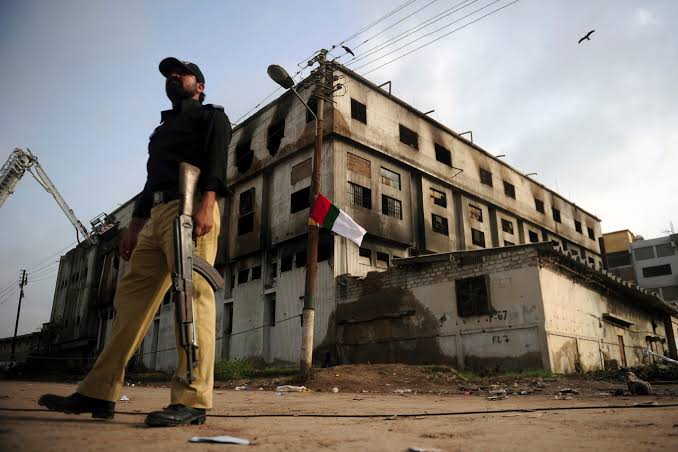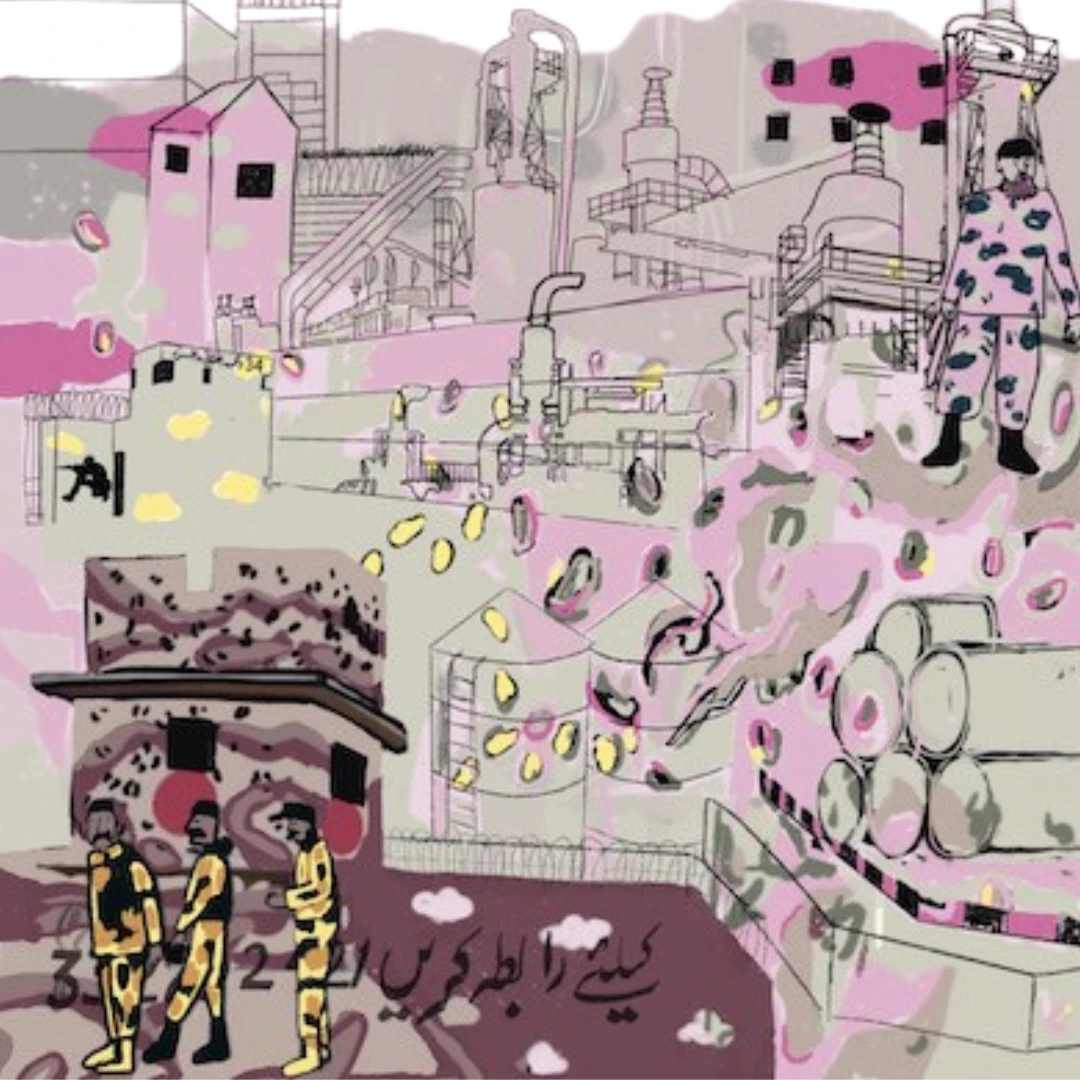Labour movements, once flourishing in Pakistan—particularly in the 1960s and early 1970s—are now a sliver of their past. There is little public debate about labour rights, factory workers’ employment conditions and reforms needed to enhance their safety and security. This is even after the deadly fire at the Ali Enterprises textile factory in Karachi in 2012 that killed over 250 workers—an unprecedented tragedy worldwide—one that should have resulted in widespread reforms in the industrial sector; a ‘never again’ moment so to speak. In his book, Gunpoint Capitalism: Enforcing Industrial Order in Karachi, Laurent Gayer astutely helps readers understand why. Through a historical and sociological study focusing on Karachi’s textile and clothing industry, he brilliantly demonstrates how industrial ‘order’ and control is maintained in the manufacturing sector, particularly in the midst of rising urban conflict; and how, to paraphrase the words of a worker he interviewed, worker rights are taken away, effectively, at gunpoint.
Gayer’s principal argument is that capitalist accumulation in today’s globalised economy rests firmly on predation. In contrast to Marxist theories that suggest that the use of direct force for surplus extraction declines in capitalist societies, or theories that explain greater managerial control in firms largely as outcomes of Taylorian principles of management, Gayer maintains that present-day capitalism cannot be understood without recourse to more violent (and insidious) forms of control and coercion. He contends that such predatory logics cannot be seen as relics of the past, nor are they limited to places where industrialisation took place in the 19th and early 20th century. In contrast, they are representative of growing efforts to ‘neutralise or even dismantle regulatory mechanisms’ by the very companies that require greater accountability—a process increasingly in play particularly since the 1980s.
He further notes that corporations have relied on private specialists in violence (he dubs them ‘capital’s henchmen’) since the early 19th century under industrial capitalism. While their active involvement has varied over time, he finds that such private actors have simply reinvented themselves in different forms with the passage of time. Employers, Gayer shows, have continued to rely on violence by teaming up with such henchmen—with state actors’ tacit approval and acquiescence. The primary aim of this book, as he writes, is ‘to restore the henchmen of capital to their rightful place in the general dynamics of capitalism’. These are, as he writes, ‘specialists who mobilise knowledge, skills, networks in response to demand for order and security’. But he does this, and more, by remaining attentive to wider structural and ideological transformations that have also enabled predatory interventions.
His arguments are based on seven months of fieldwork in Karachi spread over seven years (2015–2022), where he conducted approximately 160 interviews with factory employees, activists, lawyers, labour inspectors, government representatives and private security personnel. Unable to secure access to the shopfloor, Gayer relies on what he calls a ‘synoptic’ perspective that examines developments and dynamics at the scale of the city. While shopfloor access would have certainly enriched our understanding of working conditions, focusing on the mechanisms through which the city shapes, and is shaped, by its business elite, is a key strength of the book.
The book is structured into nine chapters aside from the introduction and conclusion, and begins with the tragic day of the Ali Enterprise fire, highlighting its place within global value chains and finding it to be critical in examining present-day global capitalism models.
Each chapter is empirically rich, bringing to life the actors and predatory logics that directly shape everyday life for working class groups. Collectively, he raises several questions not just on the issue of safety itself (and who gets to feel more safe), but on urban citizenship and rights, as well as power within urban environments.
One of the book’s biggest strengths is its attention to Karachi’s specificities while also finding similarities and parallels with other contexts. Throughout the book, Gayer refrains from exceptionalising Karachi and draws on what he calls ‘family resemblances’ with other countries and contexts. It is in this spirit that the first chapter of the book, in fact, begins not with Karachi but with the United States and also draws attention to repressive tactics used by employers in Europe and beyond using analysis based on archival work in the United States and United Kingdom.
This chapter largely focuses on practices instituted by Ford Motor Company’s service department in the early 20th century United States to demonstrate how corporate actors relied on private police forces to maintain order and control, including violent brokers and anti-union mercenaries. He details the kinds of repressive tactics and strategies used by the company to control its workers, including kidnapping, spying and intimidation. As a reader unfamiliar with this history, the extent of the repression made this chapter a rather shocking read. While outlining the evolution of such practices over time, he also highlights the complicity of the state in the process and also writes at length about the ‘notion of industrial peace’ that again seeks to criminalise actors who express discontent.
Following this, the book pertains specifically to industry in Karachi, introducing the reader to different kinds of ‘productive and coercive’ actors in the manufacturing economy in the city, and the changing configurations of relationships between them. In neatly sectioned chapters, Gayer introduces us to a range of players in the Karachi industrial complex and provides context to the way the arena has evolved.
In chapter two, for example, we are introduced to the figure of the seth and how industrial capitalism emerged in the 1950s/1960s in Karachi. Here, Gayer argues that ideas about Pakistan’s national security were used to crack down on labour activities.
Following this, in chapter three, we zoom in on the various henchmen that industrialists rely on to maintain order in the factory: ranging from the ‘jobber’ to the dada to chowkidars, alongside retired faujis and the police. Chapter four, ‘The Tremors of the City,’ elaborates how industry has itself been shaped by civil unrest in Karachi and the ethnicization of politics, particularly between 1985 and 2015, contributing to new kinds of risks and ‘interdependencies’ between industrialists, political parties and sectarian organisations. Chapter five, beginning with the tragic lynching of a Hindu worker, focuses more closely on the deepening of ties between business elites and political and criminal actors—all to the detriment of workers.

Chapter six draws the reader’s attention to the state and the means through which state institutions have aimed to ‘restore order’ (although I prefer ‘control’ over ‘order’) in the city via anti-terrorist and anti-crime operations. It highlights the state’s repeated reliance on extrajudicial violence to maintain control, and the ties between industrial and state actors that have served to restrict union activity and organising.
Chapter seven focuses on the formation and operations of the Citizen-Police-Liaison-Committee (CPLC), an organisation founded by the city’s businessmen with the support of the provincial government to liaison between citizens and the police. In this chapter, he asks whether the CPLC has over the course of time, operated increasingly like a private police force, largely for the interests of the well-to-do.
As a reader with a background in urban planning, I was most fascinated by this part of the book. Gayer highlights the organisation’s initiative to digitise and spatially analyse data on crime and its efforts to utilise the data (as well as ideas about the poor) to build walls, add check points and demolish low-cost roadside hotels around industrial areas. While these interventions are regarded as a success by business communities, Gayer illustrates how they have restricted the mobility of working class groups and made their neighbourhoods more unsafe. This on its own is a valuable contribution as local residents’ perspectives are typically missing from evaluations of initiatives such as the CPLC.
Subsequently, chapter eight highlights the vulnerabilities of existing security arrangements, by focusing on the distrustful relationship between businessmen and their private security guards and watchmen, largely due to the latter category’s working class backgrounds. He also draws attention to how security guards, who are at the helm of new spatial interventions, feel increasingly insecure and unsafe themselves, as they are first targets in the event of conflict.
The question of power is in fact central. Gayer shows that while economic elites are able to circumvent the law and engage in extra-legal violence in collaboration with the state, they continue to sidestep their own obligations and evade existing labour laws and regulations that protect workers.
Coming full circle, chapter nine pulls together all the players highlighted in the previous chapters, including the factory owner, the henchmen deployed by owners the dada and goonda, the contractor, the fauji, alongside other state actors. It returns to the fire at Ali Enterprises—the starting point of the book, focusing on the legal proceedings around the case, demonstrating how factory owners were largely exonerated of wrongdoing through the confessions of local henchmen.
Each chapter is empirically rich, bringing to life the actors and predatory logics that directly shape everyday life for working class groups. Collectively, he raises several questions not just on the issue of safety itself (and who gets to feel more safe), but on urban citizenship and rights, as well as power within urban environments.
The question of power is in fact central. Gayer shows that while economic elites are able to circumvent the law and engage in extra-legal violence in collaboration with the state, they continue to sidestep their own obligations and evade existing labour laws and regulations that protect workers. Within local factories, he finds that the majority of employees presently are casual workers, even as it is illegal to offer temporary employment beyond a three-month period. Workers therefore lack job security, are denied social security and employees’ old-age benefits, have to work long-hours, and have to comply with arbitrary whims of their employers—all under the watchful eyes of contractors and a host of local strongmen. This, he notes, contributes to further precarity, and in certain cases, depression amongst workers.
Yet, there is little public outcry to hold employers accountable. Gayer shares a grim figure: even after the devastating fire in 2012, less than 15% of garment workers now have access to a fire escape. Here, one sees a departure from other country contexts where such events result in collective action and wide-spread reforms.
While the book is about the manufacturing sector, there are, as Gayer also notes, several parallels with other sectors in the economy leaving significant room for further investigation and inquiry—there certainly are in my own research on urban land markets in Pakistan. Although, I find it is important that while we think about violence and coercion, we also look beyond it to be able to understand recent transformations, particularly in the peripheries of our cities.
The book is a comprehensive account of the industrial economy in Karachi, leaving few aspects unexamined, but I did wish it contained a deeper exploration of the military’s influence in the city’s economy and wider urban trajectory. Given the book’s already ambitious scope though, and the fact that the author consistently draws attention to this across different chapters, it is perhaps too much to ask for in one title.
Gunpoint Capitalism is an excellent contribution to scholarship on the new history of capitalism and urban political economy, speaking to a wide variety of readers and convincingly demonstrating the predatory logics of capitalist accumulation. It leaves readers with a more informed sense of the obstacles and challenges working class groups face in contemporary Pakistan.
While the question of how the most vulnerable can win their case in a society where the force of law seems to constantly be undermined looms large, Gayer does not give into the doom. Refraining from characterising such vulnerabilities as inevitable outcomes, he leaves us with a hopeful note for the future of the industry, and the city.





